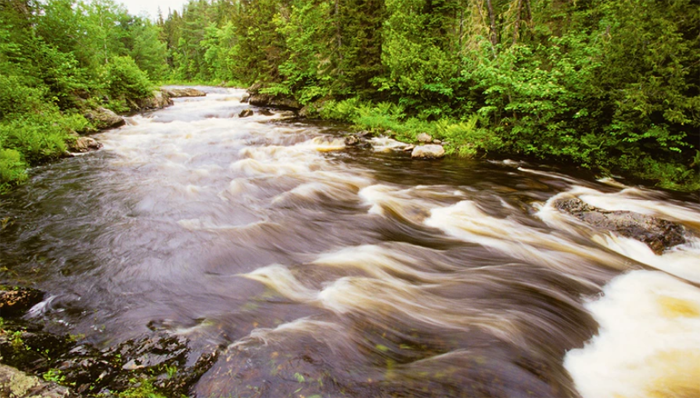
A long exposure photograph shows a tributary of the Northwest Miramichi, where the Collaboration for Atlantic Salmon Tomorrow wants to release thousands of hatchery-raised adult salmon. Photo Randolph Ashton
Collaboration for Atlantic Salmon. Tomorrow’s Smolt to Adult Supplementation, and Atlantic Salmon Federation’s vision for the Miramichi
By Jonathan Carr, Neville Crabb, Geoff Giffin, Robert Otto, Steve Sutton, and Nathan Wilbur / August 15, 2019
Note 1. Acronyms: Collaboration for Atlantic Salmon Tomorrow’s [CAST], Smolt to Adult Supplementation [SAS], and Atlantic Salmon Federation [ASF].
[dropcap]T[/dropcap]he Miramichi is at a cross-roads. People who care about the river and its wild Atlantic salmon are anxious for action to address the changes unfolding before our eyes. Livelihoods, cultures, and an entire ecosystem depend on what happens next. With the stakes so high, we can’t just do something. To heal an injured river we must do the right things.
As leaders in an organization with more than 70-years of Atlantic salmon conservation experience, we know that a lack of spawning salmon is not the problem on the Miramichi. It is a symptom of human caused and natural changes that have altered the habitat fish depend on.
Our vision for the Miramichi is based on addressing the root causes of decline. There are things we can do quickly, and work is already being done to return more fish to the river next year. Over time, we can make the entire watershed more robust and resilient for decades to come.
We ask people to read on with an open-mind and be prepared to ask hard question of not only ASF, but others as well.
The elephant in the room
We have been challenged to explain why ASF does not support the Collaboration for Atlantic Salmon Tomorrow’s (CAST) plan to release thousands of wild-captured, hatchery-raised salmon in the Northwest Miramichi river system.
We’ve been reluctant to say much, mostly in an attempt to keep peace within the salmon conservation community, but unfortunately this has allowed misinformation to spread. People are being told that CAST’s smolt-to-adult supplementation (SAS) is a quick fix for issues plaguing the Miramichi. This is not true.
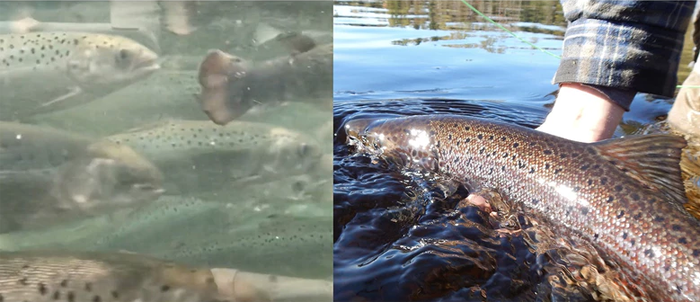
A screenshot from a recent Miramichi Salmon Association video posted to YouTube shows CAST SAS salmon inside the South Esk hatchery. On the right, a wild Northwest Miramichi salmon is ready to be released.
SF staff and many others have serious reservations. We do not believe the large-scale release should proceed and we would not be living up to our mission if we didn’t say so. Conservation should not put the species you’re trying to help at further risk. CAST SAS is not a stocking program. It is an unnecessary experiment on wild salmon.
The CAST SAS experiment
The CAST team is made up of smart people who want to do right by the Miramichi. SAS appears to be a positive twist on conventional adult to juvenile stocking. However, in their desire to get salmon out of the hatchery and into the river to spawn, the people behind CAST have consistently downplayed the risk and oversold the benefit.
To understand why this is true, it’s important to look at the December 2017 project proposal submitted to DFO from the CAST science team. The writers are explicit: “the CAST SAS project is an experiment and not a stocking program.” They go on to explain that in order to understand whether SAS could have benefits for the Miramichi it is critical “to first assess the effectiveness and risks of a SAS conservation strategy before a full implementation.”
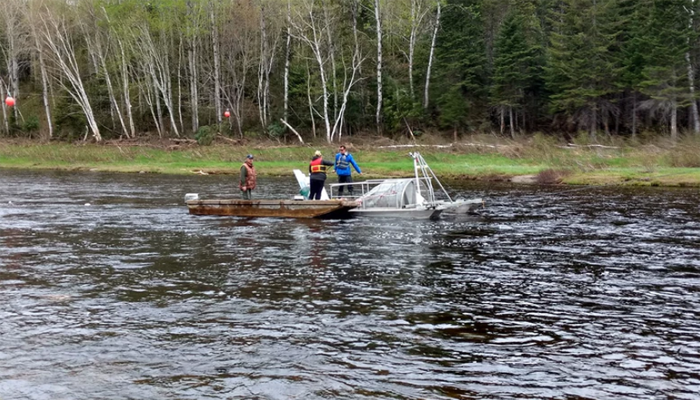
The CAST team has collected thousands of wild smolt using wheels like this to bring inside the South Esk hatchery.
In other words, the experiment proposed by CAST is neither intended to, nor is capable of increasing Atlantic salmon populations in the Northwest Miramichi system. As identified in two reviews conducted by DFO and outside experts, one in 2016 and another in 2018, the experiment comes with population level risks, like the loss of critical adaptations and the transfer of disease. On the other hand, the potential benefits are academic, like the “opportunity to obtain information about an alternative approach to population supplementation.”
The CAST team, in their written proposal, does not claim that there will be any population level benefits from the current experiment. Furthermore, it would take five to 10-years for the experiment to run its course, a necessary step before any informed decision on a large scale stocking program could be made.
Can information be gained elsewhere?
Given that the full-scale CAST SAS experiment is not designed to increase the number of returning adults to the Miramichi, and the associated risks would be seriously elevated at a larger scale, we must ask ourselves if the knowledge the CAST team is hoping to gain can be learned elsewhere, without putting a viable, yet vulnerable population of wild Atlantic salmon at risk. The answer is yes.
There are four smolt-to-adult experiments underway in New Brunswick, including one led by CAST on the Northwest Millstream in the Miramichi watershed. Others include DFO’s long-running SAS stocking of the Tobique River, and relatively new programs on the Upper Salmon and Petitcodiac rivers in the Inner Bay of Fundy.
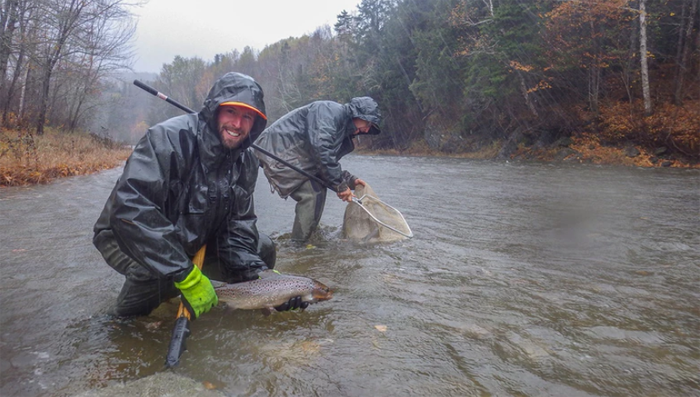
ASF’s Nathan Wilbur prepares to release an adult SAS salmon into the Pollett River, a tributary of the Petitcodiac.
In each case, more work needs to be done to analyze results, or it’s too early to know what’s working and what’s not. It is impossible to rush salmon and we must allow these projects to play out. The results will help inform decisions on whether the SAS strategy is appropriate on rivers that still have viable wild populations.
ASF is supportive of each of these experiments, including CAST’s controlled project on the Northwest Millstream. The lack of wild fish in these locations nullifies the risks outlined in the expert reviews of the CAST SAS plan.
Where does SAS fit on the Miramichi?
With multiple experiments well underway, and acknowledgement from the CAST team in their project description that “the Northwest Miramichi still meets general standards for a minimum viable population” of wild Atlantic salmon, ASF’s position is that SAS poses too many risks without providing any population benefits. Whether or not stocking should proceed is a question of timing and circumstance. Neither favour the CAST SAS proposal.
People must realize that any potential benefits of a SAS program are a long-way off and highly uncertain. Meanwhile, there are huge, pressing problems on the Miramichi that can be tackled right now, with significant work already underway.
The Root Causes of Decline
-
1. Predation
Anyone who has witnessed the spectacle of striped bass spawning in the Northwest Miramichi estuary knows that something is amiss.
Based on 14-years of tracking smolt alongside the Miramichi Salmon Association, ASF and DFO scientists just published the world’s longest study of wild Atlantic salmon. We found that in recent years, less than three-in-10 smolt leaving the Northwest Miramichi make it through the estuary. Before the striped bass population began to explode in 2010, 70 per cent of those smolt would survive the same trip through Miramichi Bay to reach the Gulf of St. Lawrence.
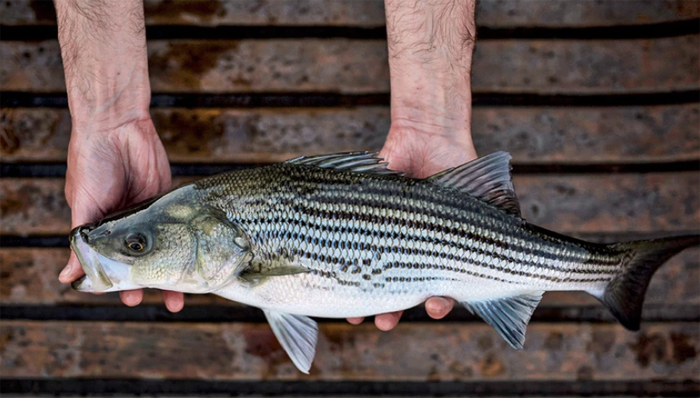
The entire southern Gulf of St. Lawrence striped bass population spawns in the lower reaches of the Northwest Miramichi. Adult striped bass gather at the same time smolt are headed for the ocean, creating a deadly overlap.
It’s an extreme example, but in 2017, when the number of spawning striped bass was estimated at 994,000, ASF research shows only eight per cent of smolt leaving the Northwest Miramichi made it through the estuary.
When you compare the radical decline of Northwest smolt to other nearby ASF study rivers, like the Restigouche and Cascapedia, smolt survival through their respective estuaries has remained relatively high and unchanged since 2003. Striped bass are consuming and injuring huge numbers of juvenile Miramichi salmon, especially from the Northwest.
What’s being done and what more can we do?
The entire salmon community, including First Nations, has rallied together and made it clear to Ottawa that standing by and watching one species decimate another is not acceptable. Sustained pressure over several years has resulted in a relaxed recreational bag limit and the opening of a First Nation commercial striped bass fishery.
It’s time to go further. DFO does not have a management target for striped bass, and the department’s ability to count the spawning population is weak. The entire salmon community needs to agree on a management target that recognizes the place of striped bass in the ecosystem and the fisheries it supports, while giving salmon the respect and space it deserves. Then, all together, we must push DFO to actively manage the striped bass population.
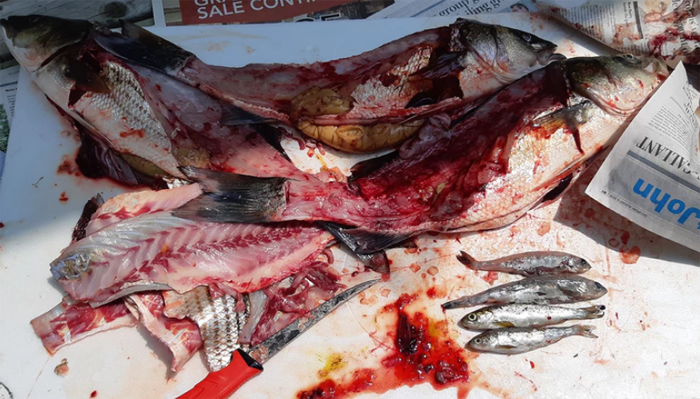
Striped bass caught cruising the Quarryville Pool on the lower Southwest Miramichi were filled with smolt in June 2019. Photo Geoff Giffin
Positive change on striped bass is a fisheries management decision away, but progress has stalled. Efforts can be revived tomorrow and ASF is prepared to work hard with all our partners to drive this change. For each 100-smolt spared, 2-3 adults will return from the sea.
-
2. Warm water
The Miramichi is warming up faster than anyone predicted. This is climate change exacerbated by what people observe all around – an ever-growing patchwork of clear-cuts and logging roads. New Brunswick, and especially the Miramichi river basin, has been cut-hard with little in the way of protected areas. As a result, the land now provides minimal protection against increasingly extreme weather.
Last year, the Little Southwest Miramichi reached 23 degrees Celsius (73 Fahrenheit) for 57-days while all main branches of the river peaked close to 30 Celsius (86 F). Atlantic salmon are cold-water fish and do best at temperatures less than 20 degrees Celsius.
Bare land and even-aged stands of nursery trees can’t match the natural benefits of a diverse, mature forest. Tree cover keeps the warm spring sun off the snow, it slows the melt and lets more cold-water percolate into the ground, which in turn seeps gradually into the river. The same is true after a heavy summer rain. The mass of roots in a forest of large trees prevent erosion and hold the banks of brooks and streams in-tact.
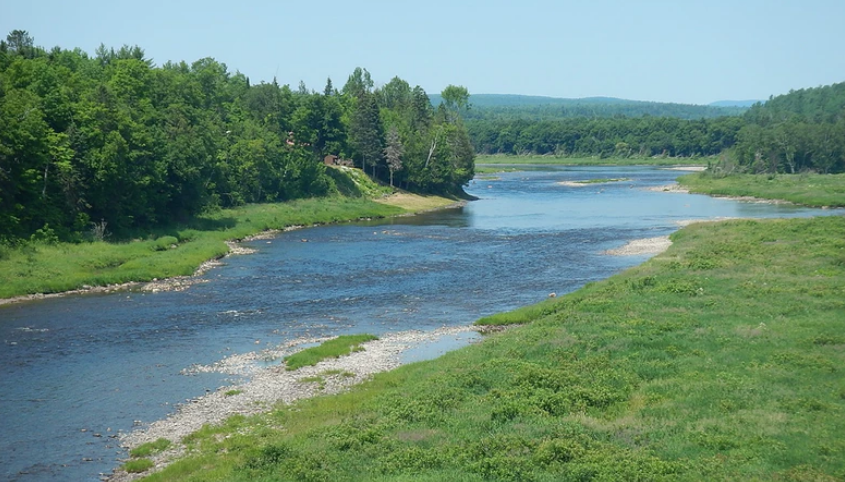
In July 2015, the Southwest Miramichi near Bloomfield Ridge was extremely low.
In recent years, people who have spent their entire life on the Miramichi have observed a rapid rise and fall of water levels after a heavy rain. What used to take a week or more happens now in a couple days.
What’s being done and what more can we do?
Building on the work of the Miramichi Salmon Association, ASF has teamed up with the North Shore Micmac District Council, MSA, and the University of New Brunswick to carry out the enhancement of 11 cold-water refuge sites throughout the Northwest and Southwest Miramichi, with an emphasis on publicly accessible water. Work will begin this year. Using engineering knowhow and natural materials to create critical cold-water habitat will give salmon a chance to survive the heat and adapt in the face of a changing climate.
However, if we don’t look further upstream, the brooks and headwaters that still produce cold-water are at risk of becoming warm and dry. Canada has committed to protecting 17 per cent of terrestrial areas and inland waters by 2020. It’s a sad fact that the Miramichi basin, where people derive incredible benefits from nature, is stuck at around three per cent protected land.
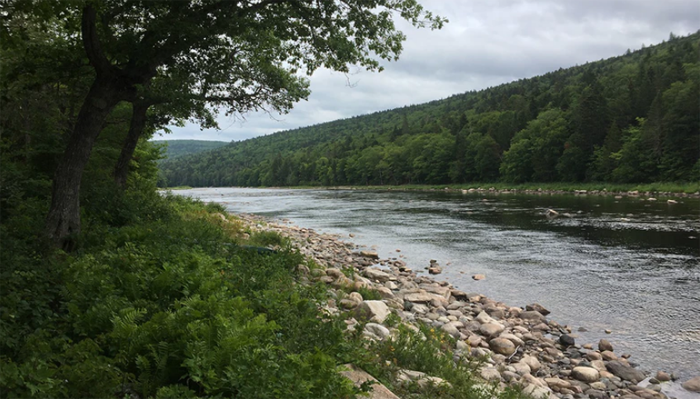
The upper Southwest Miramichi River in August 2019. Photo Nathan Wilbur
It will take the entire salmon conservation community to stand up and initiate change, and it will require forestry companies cutting on public and private lands to look honestly at the impact of their operations. ASF is calling on the government of Blaine Higgs to fulfill its campaign promise and re-write the Crown Lands and Forests Act, including significantly increasing the amount of protected land in the Miramichi watershed.
-
3. Fisheries
Decades after the closure of commercial net fisheries, and with the adoption of important conservation measures in Indigenous and recreational fisheries, local Miramichi salmon harvests may be at the lowest level in history.
However, some of these conservation benefits are being lost to mixed-stock fisheries in Labrador and particularly Greenland, where salmon from more than 2,000 rivers around the North Atlantic congregate and feed.
Greenland is home to the last remaining commercial fishery targeting wild Atlantic salmon from North America. To understand its impact on the Miramichi, the 2015 season provides a good example. Greenland fishermen took a reported 58 metric tons of wild Atlantic salmon that year, equal to approximately 17,500 large fish.
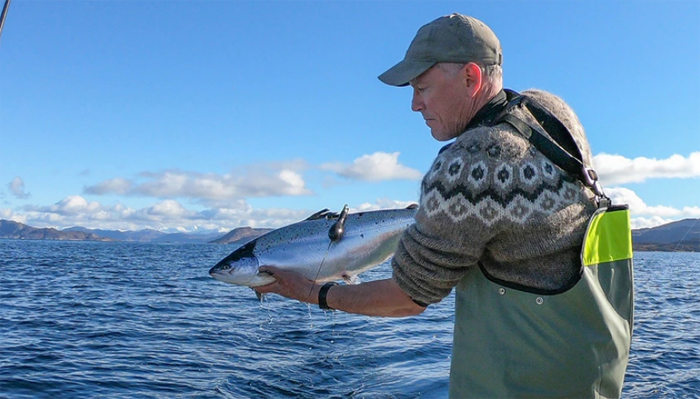
ASF V.P. of Research Jonathan Carr prepares to release an adult Atlantic Salmon fitted with a satellite tag off the west coast of Greenland. In 2018, ASF and the United States National Oceanic and Atmospheric Administration launched a multi-year study to tag adult Atlantic Salmon off Greenland and follow their homeward journey. Photo Tim Sheehan, NOAA Fisheries.
Based on annual scientific reports issued by the International Council for the Exploration of the Sea’s Working Group on North Atlantic Salmon, in 2015, more than 2,000 adult salmon taken at Greenland may have been from the Miramichi.
What’s being done and what more can we do?
In May 2018, ASF and the North Atlantic Salmon Fund signed a twelve-year agreement with Greenland’s professional salmon fishermen to suspend their commercial catch for 12-years, with all fishermen in the country holding to a 20-metric ton food fishery. We have raised more than $2-million to support this agreement.
Once salmon have reached adult size, it’s estimated that 70 per cent will survive the homeward journey. Reducing the catch at Greenland has the same effect as smolt-to-adult-supplementation with the added benefit of natural selection.
There were hiccups in the first year of the Greenland Salmon Conservation Agreement. Catch reporting from coastal communities did not travel back to Nuuk on time and the fishery was allowed to continue, unknowingly, after the 20-metric ton cap was reached. ASF and our partners in the agreement decided the best thing for salmon was to make improvements and persist.
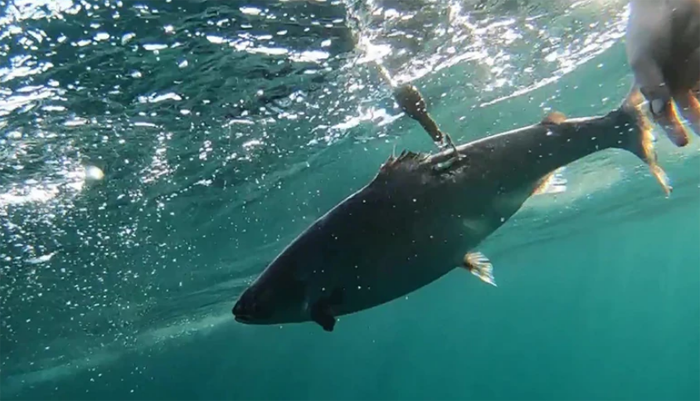
ASF V.P. of Research Jonathan Carr prepares to release an adult Atlantic Salmon fitted with a satellite tag off the west coast of Greenland. In 2018, ASF and the United States National Oceanic and Atmospheric Administration launched a multi-year study to tag adult Atlantic Salmon off Greenland and follow their homeward journey. Photo Tim Sheehan, NOAA Fisheries.
The 2019 Greenland salmon fishing season opens later this month and all the partners have agreed to a new system for reporting, with leadership and support from the Greenland Government. Over the next 11-years the Greenland Salmon Conservation Agreement will boost large salmon returns throughout North America.
It’s also important to look at the situation in Canada. Poaching continues to be a problem with an estimated 25 metric tons of wild Atlantic salmon taken illegally last year. Reports of poaching on the Miramichi have recently surfaced on social media.
A poached salmon comes from the 2-3 percent of fish that have survived their ocean migration. Acting together, the salmon community can help by being on the river, advocating for robust enforcement, and reporting issues.
A comprehensive plan for a healthier, more resilient river
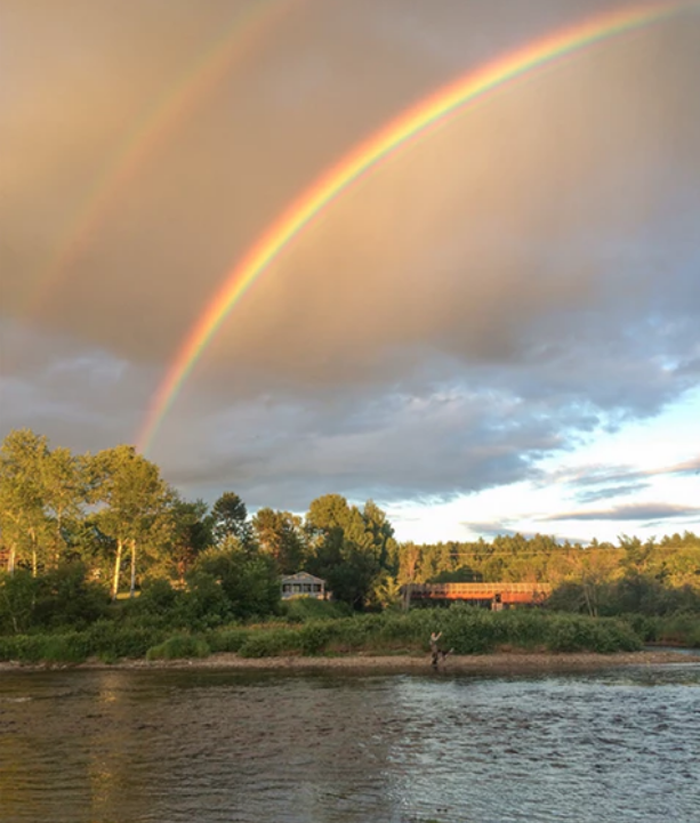
Fishing for a pot of gold on the Southwest Miramichi near Boisetown, July 2016. Photo Nathan Wilbur
Addressing excessive predation by striped bass, warming water, and ensuring all fisheries for Atlantic salmon are sustainable can increase the number of returning of wild Atlantic salmon immediately and make the river healthier and stronger for generations to come.
Miramichi salmon need a hand and ASF is doing much in close collaboration with our conservation partners. We recognize that people have a desire for groups and First Nations to work together and that is exactly what ASF has continued to do, setting aside differences over CAST.
Our focus is on tackling root causes and helping rivers be healthy. If we’re successful, there will be no need to stock.
Note 2. The republishing of this story is with permission granted by the Atlantic Salmon Federation.
Join the Atlantic Salmon Federation and help restore the King of Fish, and become a better angler.

A Quebec Atlantic salmon – commissioned work. Artist Thom Glace.

